The Benefits of Direct Messaging for EHR Interoperability
Government healthcare officials want electronic health record (EHR) systems nationwide to be interoperable by the year 2024.
There are still many technical and political challenges keeping software vendors from fully achieving this goal—but medical practices don’t have to wait years to start exchanging patient data electronically.
Thanks to Direct messaging technology, providers can practice EHR interoperability right now.
Since only certain EHRs have Direct messaging functionality, we compiled a list of questions and answers that will help you select the right software for interoperability in healthcare.
We interviewed Dr. David C. Kibbe, head of DirectTrust (a nonprofit that supports and promotes Direct messaging), to share his expert insights.

We are close to health information network interoperability, and the infrastructure for direct is a big part of that.
Dr. David C. Kibbe, DirectTrust President & CEO
1. What Is Direct Messaging?
Direct secure messaging, also known simply as Direct, is The Office of the National Coordinator for Health Information Technology (ONC) operates under the U.S. Department of Health and Human Services name for a set of communications and security protocols that facilitate “point-to-point communication and sharing of patient data between providers.”
In other words: Direct is a standardized way of exchanging health information over the Internet. It’s similar to email, but the difference is Direct messages are authenticated and encrypted in a specific way to ensure sensitive data is sent and received by authorized parties only.
“This allows practices to be able to connect without using fax machines, couriers or mail services,” says Kibbe.
He adds that a growing number of physicians are now using Direct to communicate with patients, too. Many do this by using Direct-enabled messaging modules in their patient portal solutions.
2. What Do Direct Interfaces Look Like?
Some EHR vendors are especially good at designing Direct messaging interfaces that doctors can use with little or no training involved. Both vendors showcased below are members of DirectTrust: This means they’ve been accredited by the organization after undergoing an audit to ensure their products are “trustworthy agents and service providers for Direct exchange services.”

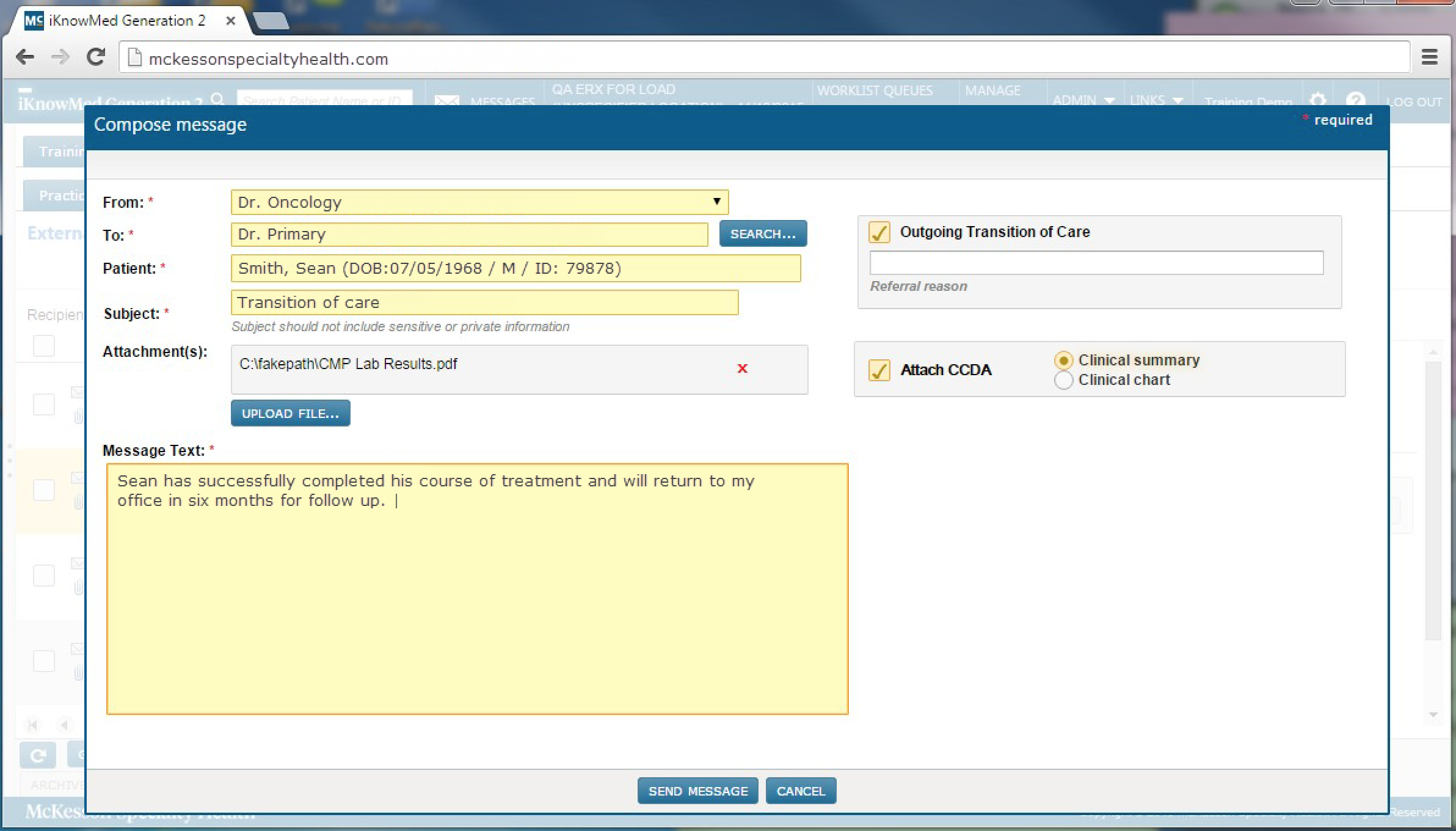

McKesson’s Direct interface, showing an oncologist messaging a primary care physician to discuss a patient’s completed treatments and coordinate care
Direct interface benefits: The intuitive design here resembles popular email clients, such as Gmail or Yahoo Mail, and there is a dedicated field for clinicians to upload multiple attachments.

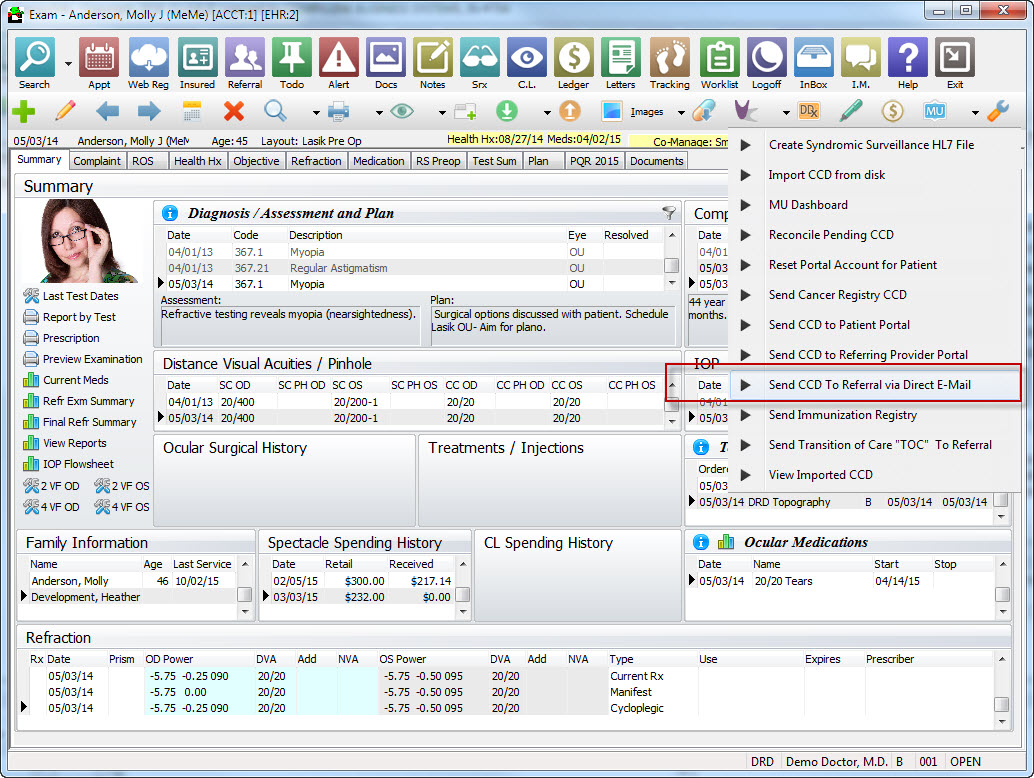

Compulink EHR user preparing to send a Continuity of Care Document (CCD) as part of a physician referral
Direct interface benefits: Protected health information can be sent directly from the patient summary window, minimizing the amount of clicks required to share clinical documents.
3. How Is Direct Related to EHR Interoperability?
Using Direct is a significant step toward practicing EHR interoperability. This is a big deal, considering complaints about the lack of connectivity between EHR systems are common from practitioners of every size and specialty.
“Even the smallest medical practices in the smallest communities are facing this issue of, ‘how do we move data electronically across the boundaries of health information technology systems?’” says Kibbe.
Lawmakers and health information technology (IT) companies are trying to determine the logistics and policies that would allow for an easily accessible, yet secure, way to interface between software systems. However, patient data doesn’t have to stay locked in a digital silo while you wait for that to happen.
Here are some examples of the types of patient information that can already be shared among practices that use Direct capabilities in their EHRs:
Information Shared via Direct Secure Messaging
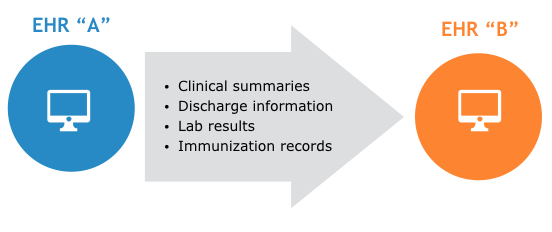
4. How Many Practices Use Direct?
More than 52,000 healthcare organizations in the U.S. are being served by accredited health IT providers in the DirectTrust network alone, according to Kibbe. There are also providers using Direct through service providers outside the DirectTrust community—so the actual number of Direct-enabled organizations is even higher.
“This is a very, very big network,” says Kibbe. “We’re now up to 10 to 15 million transactions per month and growing.”
Every quarter, he explains, more healthcare providers are creating Direct addresses—which are similar to email addresses—in order to start sending messages. (We’ll explain how to obtain a Direct address later in this report.)
Number of Individual Addresses in DirectTrust Network
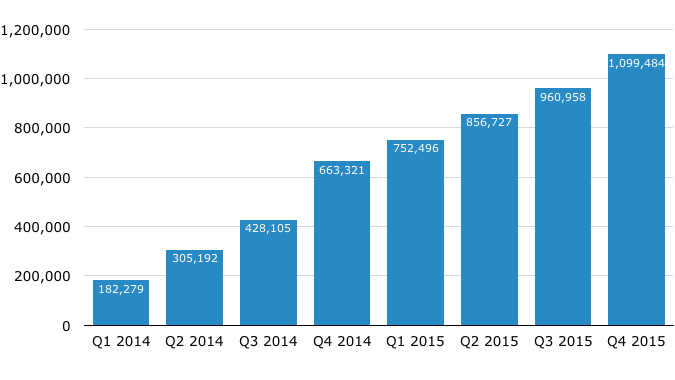
Source: DirectTrust
More than 1 million health care workers in the country are registered to use this technology. These impressive numbers indicate that providers recognize the value of Direct, and are eager to implement it. However, we should note that a significant external factor is contributing to this rapid growth, as well.
In stage two of the Meaningful Use (MU) program, Direct is explicitly cited as one of the ways providers can meet the health information exchange requirements for attestation. Now that the Centers for Medicare and Medicaid Services (CMS) has announced MU will end earlier than expected, it will be interesting to see if Direct adoption maintains the same momentum.
5. Are There Any Complications With Using Direct?
While the rise in Direct adoption is encouraging, some physicians don’t think it’s catching on fast enough, and have concerns about its ease of use.
Dr. Medhavi Jogi, a Houston-based endocrinologist, says the vast majority of his colleagues don’t even know what Direct is.
“I work with multiple hospital systems, and I only know of a few young doctors who seem sort of interested in it,” says Jogi. “I had to spend a lot of time figuring out how Direct works in my own EHR.”
Kibbe says that’s not unusual. Even though all ONC-ATCB certified EHR systems are required to be Direct-enabled, that doesn’t guarantee those capabilities will be user-friendly or particularly effective. But don’t get discouraged just yet.
“Vendors are generally getting better at incorporating Direct, because their customers are asking for it,” says Kibbe. “This is a problem that is very similar to what we had with the early integration of e-prescribing.”
The EHR user interfaces for e-prescribing used to be quite awful, he explains, often requiring dozens of clicks to prescribe a single medication. But today, dozens of e-prescribing software vendors offer sharp, intuitive designs, and the technology is used nationwide. Kibbe expects a similar evolution will happen with Direct—especially with so many doctors implementing it.
And the good news is there are vendors doing a great job of providing Direct services right now, as pictured in the screenshots from McKesson and Compulink earlier in this report.
6. Why Should My Practice Implement Direct?
Despite the potential challenges, it’s still a good idea for your practice to use Direct messaging due to the benefits it brings, including:
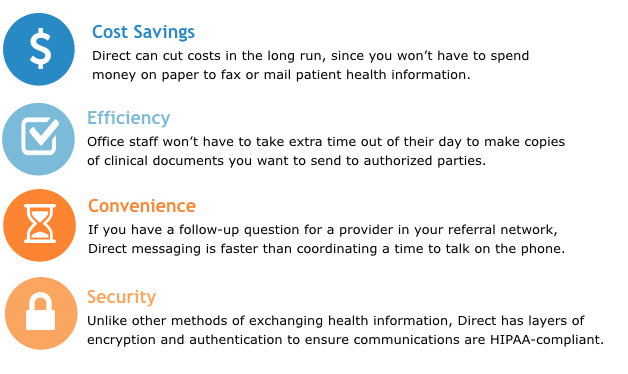
Moreover, Kibbe expects Direct will become an essential way to engage with government health care agencies in the near future, replacing mail as the preferred method of communication.
“Medicare will eventually be moving its infrastructure for exchanging information with medical practices to Direct, instead of mailing [documents to practices] back and forth,” he predicts. “That’s another benefit that is going to be very obvious, but not for another year or so.”
7. How Can My Practice Implement Direct?
First, you’ll need to obtain a Direct address. It’ll look something like this hypothetical example:
Gaby.Loria@direct.ExampleMedicalPractice.net
Health Internet Service Providers (HISPs) issue Direct addresses and provide the software you need to use them. These are the three main kinds of HISPs:
ONC-ATCB certified EHR vendors. As we mentioned earlier, EHR products that have been certified by the Office of the National Coordinator must integrate Direct in addition to offering capabilities for creating and storing patient records.
Companies that specialize in stand-alone Direct services. These companies do not offer EHR systems; however, they can be hired to handle Direct at your practice as a best-of-breed service, offered through a cloud-based application.
Health Information Exchange (HIE) networks. HIEs, which can either be independently run or state-sponsored, offer Direct messaging in addition to other interoperability services. For example, providers can sign up to access a Web-based application containing the electronic records of consenting patients, regardless of the different EHR systems used in participating practices.
Kibbe recommends using Direct through an EHR. This way, you won’t have to leave the program and sign on to an external Web application to access your account. Regardless of which HISP you choose, be aware of any potential costs that may come with it (e.g., monthly fees or pay-per-message charges).
Once you’ve obtained your Direct address, you must determine which of your colleagues are also using Direct. DirectTrust is developing a comprehensive “Provider Directory” for this purpose (which is important, since you can’t use your Direct address to email a non-Direct address).
In the meantime, you can ask your HISP to provide a list of Direct addresses in your area—or, as Kibbe suggests, reach out to your colleagues personally.
“I would encourage physicians to be active in their communities by informing their clinical exchange partners about communicating electronically,” he says.
Once you’re ready to send a message, your HISP can help you establish a connection with the intended recipient’s HISP. And that’s it! You’re on your way to achieving interoperability of health information systems.
8. How Should I Evaluate Direct-Enabled EHR Vendors?
First of all, you should only consider ONC-ATCB certified EHRs, since other vendors may not even offer Direct messaging capabilities. However, that still leaves you with hundreds of choices—so here are some steps you can take to narrow down all those products:
Fill out this free questionnaire. If you answer a few short questions, we can pare down our database of products into a customized list of vendors that offer exactly what you’re looking for.
Call Software Advice at (855) 998-8505. In less than 15 minutes, our team of expert Software Advisors can get you all the information you need to make an informed decision. After learning your specific functionality and budgetary requirements, they’ll send you a detailed list of products that meet your needs.
Email me at gaby@softwareadvice.com. I’m available to help guide you through the software-selection process or to answer any additional questions you might have about EHR interoperability and Direct messaging. I can also put you in touch with this article’s featured expert, Dr. Kibbe.
Finally, we’ll leave you with this software checklist to reference when you’re ready to start comparing products on your shortlist:
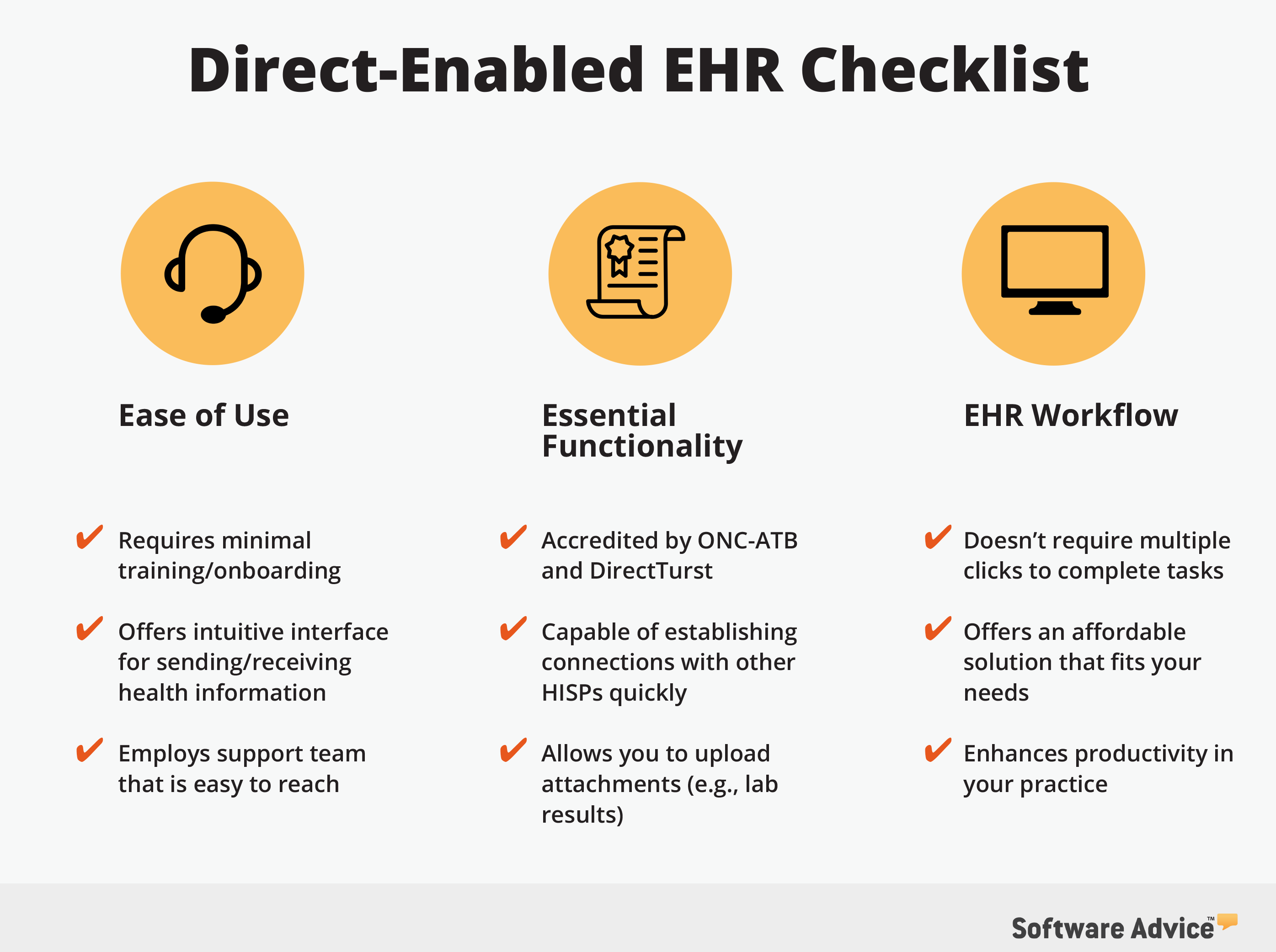
Explore Medical categories: